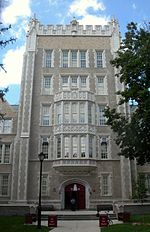Weeping Beech (Queens)

The Weeping Beech was a historic tree located at Weeping Beech Park in Flushing, Queens, New York City. It was the mother of all European weeping beeches in the United States. The Weeping Beech was imported by horticulturalist Samuel Parsons in 1846 and planted in 1847. It was designated a living New York City Landmark in 1966, one of two trees in New York City to have received that designation, and was placed on the National Register of Historic Places in 1972 along with the adjacent Kingsland Homestead. The Weeping Beech was partially removed in 1998. The region around the Weeping Beech, called Weeping Beech Park, contains a playground, the Kingsland Homestead, the John Bowne House, and several other historically significant trees.
Excerpt from the Wikipedia article Weeping Beech (Queens) (License: CC BY-SA 3.0, Authors, Images).Weeping Beech (Queens)
37th Avenue, New York Queens County
Geographical coordinates (GPS) Address Website Nearby Places Show on map
Geographical coordinates (GPS)
| Latitude | Longitude |
|---|---|
| N 40.763611111111 ° | E -73.824166666667 ° |
Address
Kingsland Homestead
37th Avenue 143-35
11354 New York, Queens County
New York, United States
Open on Google Maps










